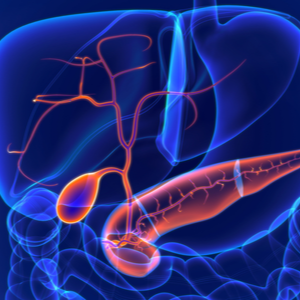
What is cholangiocarcinoma?
Cholangiocarcinoma (CCA) is also colloquially known as bile duct carcinoma and describes a malignant cancer of the mucous membrane of the bile duct. The bile ducts are a connection between the liver and the duodenum. Tumours can occur both inside (intrahepatic cholagiocarcinoma, less common) and outside the bile ducts (extrahepatic cholangiocarcinoma, more common), which resemble a river course. Cholagiocarcinoma is difficult to diagnose and is therefore almost only detected at an advanced stage, which makes the cancer almost incurable. However, it is a rather rare cancer that accounts for about 3 per cent of all gastrointestinal tumours. Cholangiocarcinoma usually only occurs with increasing age and is rather rare before the age of 40.
What are the risk factors for cholangiocarcinoma?
About 80 percent of all cholangiocarcinomas develop outside the liver. Besides hereditary factors, environmental influences probably also play an important role. Other risk factors are probably only responsible for the cancer in a small number of cases. Especially in Thailand, parasites could also be named as triggers of cholangiocarcinoma, such as Opisthochis viverrini and/or Clonorchis sinensis
Probably the most important predisposing factor, which also favours the development of cholangiocarcinoma, is primary sclerosing cholangitis. In 10 to 20 percent of all cases of primary sclerosing cholangitis, a bile duct carcinoma also develops. Congenital cysts, for example in the liver, the viral diseases hepatitis B and C, chronic typhoid infection, liver cirrhosis, gallstones and exposure to certain toxic chemicals also contribute to the development of cholangiocarcinoma.
How does cholangiocarcinoma develop?
Cholangiocarcinoma CCA can occur both inside and outside the bile ducts. The so-called Klatskin tumour is a specific type of extrahepatic cholangiocarcinoma and occurs where the right and left hepatic bile ducts meet the common bile duct (CBD). Klatskin tumour is slightly more common in men than in women. However, Klatskin tumour also only tries to cause symptoms at an advanced stage.
What are the symptoms of cholangiocarcinoma?
The location of the tumour determines which symptoms can occur with cholangiocarcinoma. If the tumour is close to the common bile duct, as is the case with extrahepatic cholangiocarcinoma, there is often painless jaundice. But whitish stools, dark urine and/or itching can also be typical symptoms. If, on the other hand, the tumour is located inside the liver, there are more non-specific symptoms such as fatigue, unwanted weight loss and/or abdominal pain.
Intrahepatic cholangiocarcinoma, which is less common than extrahepatic cholangiocarcinoma, may present with non-specific symptoms such as decreased appetite, unwanted weight loss, abdominal pain and general malaise.
How is cholangiocarcinoma diagnosed?
Because cholangiocarcinoma often causes the same symptoms as, for example, gallstones, it is often difficult to diagnose. The first valuable information is probably provided by the blood values, as they give information about the functioning of the bile ducts and the liver. However, by means of the blood values, the doctor can ultimately only diagnose that it is a disease of the liver or the bile ducts.
Only image-diagnostic examinations can confirm the diagnosis. These include ultrasound, computer tomography (CT) and magnetic resonance imaging (MRI). In addition, there are various endoscopic examinations, for example, to allow the stagnated bile to drain.
How is cholangiocarcinoma treated?
Only an operation in which the entire tumour is completely removed offers the prospect of a complete cure. However, cholangiocarcinoma is usually diagnosed at an advanced stage, so surgery is rarely used. However, in order to be able to assess this, the doctor will not only consider the tumour size, but also the characteristics of the cancer cells and the possible formation of metastases. In some cases, a liver transplant will also be necessary.
In addition to surgery, palliative therapy is also possible. This can alleviate the symptoms. In the case of cholangiocarcinoma, palliative chemotherapy is therefore usually used as standard therapy. One of the newer treatment options is photodynamic therapy. Here, the cancer cells are brought into contact with the photosensitiser, a certain substance. Through the targeted irradiation with light waves, the photosensitizers are thus altered and produce degradation products that are toxic for the cancer cells. This process should contribute to the destruction of the tumour cells. However, photodynamic therapy only slows down tumour growth a little. It is therefore not considered a curative treatment option, but rather a palliative one.
What is the prognosis of cholangiocarcinoma?
As with other cancers, the earlier cholangiocarcinoma is diagnosed, the better the chances of a full recovery. However, since cholangiocarcinoma is usually diagnosed at a very advanced stage, the prognosis is rather poor. Liver failure caused by cholangiocarcinoma and frequent blood poisoning lead to a high mortality rate. If, on the other hand, the tumour is removed completely by surgery and/or with tumour-free margins, the prognosis for recovery is good, provided the tumour has not yet spread to the lymph nodes.
